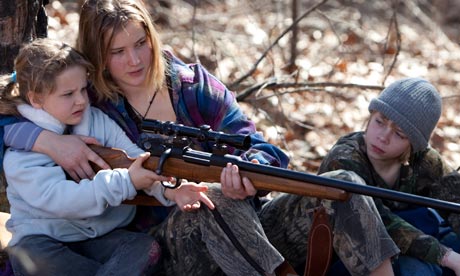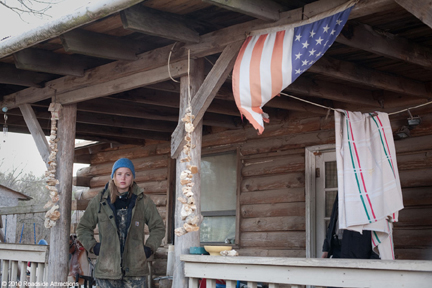Among its confluence of forces and traditions, it is impossible to ignore that the mythological potential of America is enabled, at least in part, by its sheer size. As the borders of the United States pushed relentlessly West, spaces opened up in the endless flats and dark mountains of the ‘Midwest’, where the fabric of the frontier was pulled thin. Here, populations remained frozen in time, held between a state of ‘being on the edge’ of that dangerous world, and the finality of being left behind. Upon this land, and in this world, Winter’s Bone (2010) writes a tale of heroism and bare-knuckled humanity through the experience of a teenage girl.
 The opening scenes establish the film’s arresting point of view – a gritty, observational style, on the landscape of dull light and dilapidated buildings and sheds that make up rural Ozark country. A teenage girl (Ree) carries out a continuous procession of chores and duties: including teaching her younger siblings how to shoot a gun. It’s clear that her work is holding the family together, and we soon see that the father is absent, and her mother deep in a state of depression. The neighbours help where they can, but in a world where everyone struggles, any willingness to give and accept help risks straining community. These ties and boundaries are soon tested much more dramatically, however, as a police officer arrives to announce that Ree’s father appears to have jumped bail, and the family will lose their home within days. Ree knows that if she loses the house, her siblings will be separated, and the family will effectively be dissolved. Determined to not let this happen, she begins walking – in dire need of help, in a world that knows only struggle and the fight for survival.
The opening scenes establish the film’s arresting point of view – a gritty, observational style, on the landscape of dull light and dilapidated buildings and sheds that make up rural Ozark country. A teenage girl (Ree) carries out a continuous procession of chores and duties: including teaching her younger siblings how to shoot a gun. It’s clear that her work is holding the family together, and we soon see that the father is absent, and her mother deep in a state of depression. The neighbours help where they can, but in a world where everyone struggles, any willingness to give and accept help risks straining community. These ties and boundaries are soon tested much more dramatically, however, as a police officer arrives to announce that Ree’s father appears to have jumped bail, and the family will lose their home within days. Ree knows that if she loses the house, her siblings will be separated, and the family will effectively be dissolved. Determined to not let this happen, she begins walking – in dire need of help, in a world that knows only struggle and the fight for survival.
As she searches for answers that will help her avoid the repossession, she comes face to face with the grim reality: that in order to save her family, she will have to find hard evidence of her father’s death: that is, his body. In this landscape of silent death, information is valuable, and Ree meets with a wall of refusal on every side. Yet her desperation brings her to a place that surprises and earns the respect of these people – she proves herself willing to risk her own body and life in order to save her family. This courage: the affirmation of the altruistic impulse towards survival, wins out over the selfish and competitive interests that have seared the hearts of the warring families. From their hardness, there opens up a place to help Ree, and her success is at once due to her individual courage, and through that, the creation of a glimmer of community against the deterministic wilderness that has swallowed the father. Ree’s journey, it seems, reminds us that this landscape threatens to take all of us, too – and only by aiding each other, can we hope to survive.

I first heard about this movie when my Aunt recommended it to me. She described it as ‘the best film [she’d] ever seen’, and really connected to the depiction of a strong female lead, battling against almost overwhelming opposition. Winter’s Bone is that – a kind of feminist Beowulf. But later, one of my male friends recommended it to me, for entirely different reasons: for it’s raw, realist delivery. After watching for myself, I reflected: how is it that this film can sit between the ‘real’ and the mythic, and succeed so powerfully within both spheres? The answer lies in the remoteness of the Ozarks, of course, but also in Ree’s human heart. She is a powerful protagonist – deeply good. Acting from her loyalty to her own blood, she undoes fear and death, and connects the past with the future through her heroism. If the film moves us, it is because we hope that on days when we must battle for love against death, we will be able to do the same.
;

This has been on my must-see list for quite a long time, thank you for the great review, I won’t put it off any longer.
I think art that is able to convey the particularity of human beings or places is very powerful. When I read or watch something that captures something like felt reality, It gives me a greater sense of connection with the myths, archetypes and narratives that the film or book is exploring.
I saw this film in the movie theater last year when it first came out with Clay Whipkey. Later, we met our wives and kids for an informal community pool party. When we arrived at the party a little late, a beer-drinking blue-collar dude asked where we were.
“We were seeing a movie,” I replied.
“Together? What, are you guys gay or something?” he sneered.
Taken aback, I said nothing, bemused and slightly alarmed that such high-school-locker-room razzing still took place among adults.
To fill the pause he asked, “What movie did you see?”
“Um, Winter’s Bone,” I said, immediately wishing I’d lied and said “The Expendables,” or something more masculine sounding.
His sneer turned to disgust, “Never heard of it… sounds like a Gay porno.”
Embarrassed, I attempted to explain the plot, “No, it’s this indie movie, where, um, this 17-year-old girl in the Ozarks tries to, you know, fend for her family, and, um…” My voice trailed off. I was only making matters worse. The subject was quickly changed.
So that is my memory of Winter’s Bone… the “Gay porno.”
As for the movie itself, I remember liking, but not loving it. It seemed thematically and structurally similar to many other Sundance-type movies that have come out in the past 10-15 years. But your write-up makes me want to see it again.
Great story, Matt. It’s always interesting to me how an experience with a movie in context of a person’s life adds layers of meaning. This is one that, I admit, hadn’t occurred to me from the title. :)
@Matt, you sure you weren’t transported to east Texas for that informal community pool party?? What does it say about me that when I was reading your story, the man you were talking to had a very thick southern drawl?? ;)
Nicely done. After reading a few reviews just after it came out, I put the movie on my “must see” list (and eventually followed through and saw it). It’s one of my favorites movies. @Matt, all I want to know is if you left an empty seat between you and Clay?
The so-called “not-a-fag seat,” as my high-school friend Tim used to call it? Can’t remember. But I recall holding hands during the scary parts, but that still could have been accomplished over the empty seat.
Hey, nothing wrong with a little snuggle between bros.